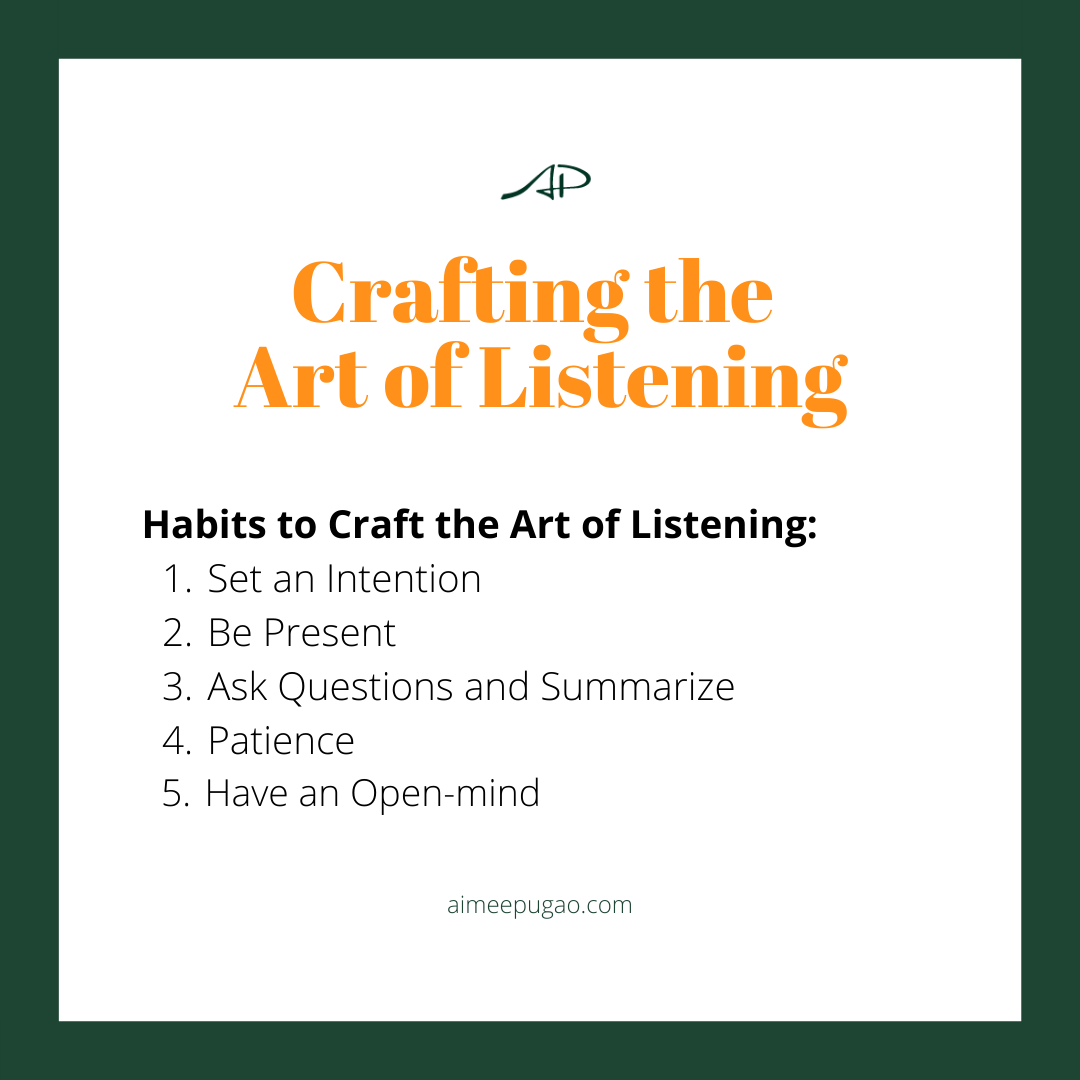Our society reveres people who have mastered the art of storytelling, public speaking, presenting views effectively. Speaking with elegance, conducting soliloquies, or captivating an audience can be lucrative and exciting.
We are used to strengthening our speaking skills, but there is another side of that coin. It is often overshadowed but is also an essential part of communicating- it is crafting the art of listening.
Barriers to Listening
We developed many habits from our busy lives to make us productive members of society. However, those same habits can play a role in creating barriers to effective listening. Some of these habits include:
Multi-tasking
It’s generally great to learn how to multitask, especially when we have many projects on the go. However, we can easily be distracted when trying to listen to more than one conversation or perform another task such as cooking or reading. Multi-taking hinders our ability to absorb what the other speaker is saying entirely, and we become more prone for our thoughts to drift beyond the speaker’s subject matter.
Eagerness
In our “need to get things done” society, we can quickly become impatient. Sometimes it can be difficult to listen attentively when other people express their thoughts and ideas if they seem confusing or illogical. Our eagerness can drive us to impatience, where we become frustrated and revert the conversation to ourselves or abandon the conversation altogether. While impatience can be lead us to productivity in our working world, our impatience and dismissiveness can erode trust and impact the quality of the relationship we want to cultivate.
Generalizing or Previous Experience
Generalizing or using our previous experience can be beneficial when making quick and timely decisions. However, it closes us off to genuinely connect with others and be open to understanding their perspective, thereby affecting our ability to listen actively.
Response Ready and Solution Focused
Many of us come from the angle of readying ourselves to respond or offering solutions. In the working world, providing solutions and concentrating on what we want to convey helps us present our thoughts effectively, makes us look polished, well-prepared and intelligent. However, these acts offer little comfort in interpersonal communication and don’t display that we are intently listening. Response-ready and solution-focused can come off as condescending rather than compassionate and empathic.
What Does it Mean to Listen?
We all have been in a position where we felt ignored or dismissed. It doesn’t feel great; it’s annoying when it comes from a boss or coworker, but it can be deeply hurtful if it comes from a loved one. We all want to be listened to, heard, and understood.
Listening involves more than just hearing someone speak. When we practice listening actively, we are fully concentrating on what others are saying. When we listen, we do it with a combination of our senses and give our undivided attention to the person speaking.
Benefits of Listening
Listening may not grant us standing ovations, hardy laughs, or label us as the life of the party. It can help support others’ heal, build connections, strengthen knowledge, trust, and better understand ourselves and others.
What people do not commonly discuss, listening can also help with our memory recall and retention. When we craft the art of listening, we are present, absorbing the ideas others are conveying. We are also picking up on the subtle emotions displayed. It becomes much easier to absorb the information into our memory when we focus on the present moment while noticing the feelings exhibited.
Initially, listening may take a conscious effort and discipline to learn, but it can become a habit. It is not difficult; any one of us can effectively develop listening skills.
Crafting the Art of Listening
Many of us are very excited to tell others what is happening in our lives, our day, or what we experienced. We forget conversations and communications are two-ways, but also four lanes. Expressing how we feel, the other understanding and vice versa. The habits we can develop to become better listeners include:
1. Setting an Intention
Crafting the Art of Listening starts with the intention to listen holistically and to understand the other person. When we set an intention, we prepare our minds for mental activities and forethought, which involve listening.
2. Being Present
Stay focused on the present moment, allow the person we are with to have our undivided attention. Remove any distractions that will cause us not to be present. Allow them to fully speak their piece and notice what they are saying and how they are feeling. If we don’t know what they are feeling, then ask once they have finished their sentence.
3. Asking Questions and Summarizing
We can reflect on what was said by paraphrasing or summarizing to ensure everyone is on the same page. If clarification is required, ask questions. Seeking clarification will reinforce our desire to understand their perspective.
4. Patience
Give the speaker time to get it all out before jumping in with our reply. Let the person speak uninterrupted. It’s okay to have moments of silence, to absorb all that is said and unspoken. Some people take longer to find the right word, form sentences, make a point, or clarify an issue. When we are patient, it provides the speaker space to feel heard, displays we want to listen, and hear what they want to say.
5. Being Open-minded
Crafting the art of listening involves being open-minded. If what the speaker is saying creates an emotional response, we can miss critical parts of what is being said. Do our best to leave our judgements aside. Even if we disagree, let them have their point of view. We are not there to change their perspective, rather to better understand them.






